Mining Social Media Data to Capture Urban Park Visitors’ Perception of Cultural Ecosystem Services and Landscape Factors
Abstract
:1. Introduction
2. Materials and Methods
2.1. Study Area
2.2. Research Design
2.3. Acquisition of Social Media Data
2.4. Processing of Social Media Data
2.4.1. Framework for Urban Park CESs and Landscape Factor Indicators
2.4.2. Establishment of CES Perception Lexicon
2.4.3. Landscape Factor Extraction Based on Image Annotation
2.5. Data Statistical Analysis
3. Results
3.1. CESs in Social Media Texts
3.1.1. The Similarities and Differences in the Perceptions of Urban Park CESs
3.1.2. Importance–Performance Analysis of Visitors at Urban Park CESs
3.2. Landscape Factors in Social Media Photos
3.3. The Correlation between Urban Park CESs and Landscape Factors
3.3.1. Interconnectedness of CES Categories in Urban Parks
3.3.2. Correlation between CES Categories and Park Landscape Factors
4. Discussion
4.1. Visitors’ Preferences for Cultural Ecosystem Service Categories and Landscape Factors in Parks
4.2. Factors Influencing Visitors’ Perception of Cultural Ecosystem Services in Park Landscapes
4.3. Methodological Advantages and Limitations
5. Conclusions
Author Contributions
Funding
Data Availability Statement
Acknowledgments
Conflicts of Interest
Appendix A
| District | Urban Park Name | Area/hm2 | Types | Number of Valid Comments |
| Xihu District | The Prince Bay Park | 80.00 | Comprehensive park | 2497 |
| Viewing Fish at Flower Pool Park | 20.00 | Comprehensive park | 1548 | |
| Breeze-ruffled Lotus at Quyuan Garden | 12.65 | Comprehensive park | 1901 | |
| Hupao Park | 13.12 | Other specialized park (theme of Tiger Running Spring) | 619 | |
| HangZhou Zoo | 20.00 | Specialized park (zoo) | 2195 | |
| HangZhou Botanical Park | 284.64 | Specialized park (botanical park) | 2991 | |
| Youth & Children’s Park | 14.00 | Other specialized park (children’s park) | 81 | |
| Agoda of Six Harmonies Park | 6.80 | Specialized park (heritage park) | 108 | |
| Xishan Forest Park | 1381.00 | Other specialized park (urban forest park) | 52 | |
| Wuchao Mountain Forest Park | 522.00 | Other specialized park (urban forest park) | 47 | |
| Tongjian Lake Park | 67.72 | Other specialized park (urban wetland park) | 59 | |
| The Xixi National Westland Park | 1150 | Other specialized park (urban wetland park) | 1026 | |
| Shangcheng District | White Pagoda Park | 78.40 | Comprehensive park | 2246 |
| Chengdong Park | 6.26 | Comprehensive park | 69 | |
| Orioles Singing in the Willow | 21.00 | Comprehensive park | 510 | |
| Bachelor Park | 12.70 | Comprehensive park | 68 | |
| Chengbei Sports Park | 44.78 | Other specialized park (sports and gymnastic park) | 52 | |
| Jiangyangfan Ecological Park | 19.80 | Other specialized park (urban wetland park) | 56 | |
| Long bridge Park | 2.80 | Other specialized park (waterfront park) | 203 | |
| The Eight Diagrams Field Heritage Park | 6.00 | Specialized park (heritage park) | 435 | |
| Lakeside Park | 5.80 | Other specialized park (waterfront park) | 53 | |
| Yongjin Park | 2.80 | Other specialized park (waterfront park) | 53 | |
| Gongshu District | Grand Canal Asian Games Park | 46.70 | Comprehensive park | 33 |
| Banshan Forest Park | 1002.88 | Other specialized park (urban forest park) | 257 | |
| Binjiang District | Riverside Park | 28.00 | Comprehensive park | 107 |
References
- Huai, S.Y.; Voorde, T.V.D. Which environmental features contribute to positive and negative perceptions of urban parks? A cross-cultural comparison using online reviews and natural language processing methods. Landsc. Urban Plan. 2022, 218, 104307. [Google Scholar] [CrossRef]
- Gao, W.; Wang, S.Y.; Chen, S.T.; Hu, S.J.; Li, H. Identifying cultural ecosystem services and relevant landscape elements provided by urban green space throughout history from an information communication perspective. Forests 2023, 14, 1045. [Google Scholar] [CrossRef]
- Gai, S.J.; Fu, J.M.; Rong, X.; Dai, L.L. Users’ views on cultural ecosystem services of urban parks: An importance-performance analysis of a case in Beijing, China. Anthropocene 2022, 37, 100323. [Google Scholar] [CrossRef]
- Kabisch, N.; Qureshi, S.; Haase, D. Human-environment interactions in urban green spaces—A systematic review of contemporary issues and prospects for future research. Environ. Impact Asses. 2015, 50, 25–34. [Google Scholar] [CrossRef]
- Millennium ecosystem assessment. In Ecosystems and Human Well-Being: Synthesis; Island Press: Washington, DC, USA, 2005; Volume 2022, pp. 26–101. Available online: https://www.millenniumassessment.org/documents/document.356.aspx.pdf (accessed on 5 January 2023).
- Dade, M.C.; Mitchell, M.G.E.; Brown, G.; Rhodes, J.R. The effects of urban greenspace characteristics and socio-demographics vary among cultural ecosystem services. Urban For. Urban Green. 2020, 49, 126641. [Google Scholar] [CrossRef]
- Zhang, Y.; Qiu, H.F. A study on public perception of Cultural ecosystem services in lake parks based on latent Dirichlet Allocation Model. Chin. Landsc. Archit. 2023, 39, 121–126. [Google Scholar] [CrossRef]
- Andersson, E.; Tengö, M.; McPhearson, T.; Kremer, P. Cultural ecosystem services as a gateway for improving urban sustainability. Ecosyst. Serv. 2015, 12, 165–168. [Google Scholar] [CrossRef]
- Huai, S.Y.; Chen, F.; Liu, S.; Canters, F.; Voorde, T.V.D. Using social media photos and computer vision to assess cultural ecosystem services and landscape features in urban parks. Ecosyst. Serv. 2022, 57, 101475. [Google Scholar] [CrossRef]
- Dickinson, D.C.; Hobbs, R.J. Cultural ecosystem services: Characteristics, challenges and lessons for urban green space research. Ecosyst. Serv. 2017, 25, 179–194. [Google Scholar] [CrossRef]
- Zuo, Y.L.; Chang, J.; Liu, W. Evaluation of cultural ecosystems services of urban park from the perspective of tourists: A case study of DaMing lake park in Jinan. J. Guilin Univ. Technol. 2023. in press. Available online: https://kns-cnki-net.webvpn.zafu.edu.cn/kcms/detail/45.1375.N.20230927.1928.002.html (accessed on 14 January 2024).
- Yang, L.J.; Cao, K.J. Cultural ecosystem services research progress and future prospects: A review. Sustainability 2022, 14, 11845. [Google Scholar] [CrossRef]
- Depietri, Y.; Ghermandi, A.; Campisi-Pinto, S.; Orenstein, D.E. Public participation GIS versus geolocated social media data to assess urban cultural ecosystem services: Instances of complementarity. Ecosyst. Serv. 2021, 50, 101277. [Google Scholar] [CrossRef]
- Luo, Y.Y.; Xu, H.L.; Zhang, J.J.; Chen, N.; Ye, H.Y.; Lei, W.Y. Magnifier or refractor? Exploring the impact of geographical indication on people’s perception of the value of cultural ecosystem services based on the SolVES model. Front. Ecol. Evol. 2023, 11, 1208169. [Google Scholar] [CrossRef]
- Ruiz-Frau, A.; Ospina-Alvarez, A.; Villasante, S.; Pita, P.; Maya-Jariego, I.; Juan, S.D. Using graph theory and social media data to assess cultural ecosystem services in coastal areas: Method development and application. Ecosyst. Serv. 2020, 45, 101176. [Google Scholar] [CrossRef]
- Wang, W.; Wu, C.Y.; Fang, Q.H.; Harrison, O.I. Cultural ecosystem services evaluation in a coastal city of China using social media data. Ocean Coast. Manag. 2023, 242, 106693. [Google Scholar] [CrossRef]
- Dai, P.C.; Zhang, S.L.; Chen, Z.X.; Gong, Y.L.; Hou, H.P. Perceptions of cultural ecosystem services in urban parks based on social network data. Sustainability 2019, 11, 5386. [Google Scholar] [CrossRef]
- Lee, H.; Seo, B.; Koellner, T.; Lautenbach, S. Mapping cultural ecosystem services 2.0—Potential and shortcomings from unlabeled crowd sourced images. Ecol. Indic. 2019, 96, 505–515. [Google Scholar] [CrossRef]
- Richards, D.R.; Friess, D.A. A rapid indicator of cultural ecosystem service usage at a fine spatial scale: Content analysis of social media photographs. Ecol. Indic. 2015, 53, 187–195. [Google Scholar] [CrossRef]
- Fox, N.; Graham, L.G.; Eigenbrod, F.; Bullock, J.M.; Parks, K.E. Enriching social media data allows a more robust representation of cultural ecosystem services. Ecosyst. Serv. 2021, 50, 101328. [Google Scholar] [CrossRef]
- Chen, Y.; Caesemaecker, C.; Rahman, H.T.; Sherren, K. Comparing cultural ecosystem service delivery in dykelands and marshes using Instagram: A case of the Cornwallis (Jijuktu’kwejk) River, Nova Scotia, Canada. Ocean Coast. Manag. 2020, 193, 105254. [Google Scholar] [CrossRef]
- Gugulica, M.; Burghardt, D. Mapping indicators of cultural ecosystem services use in urban green spaces based on text classification of geosocial media data. Ecosyst. Serv. 2023, 60, 101508. [Google Scholar] [CrossRef]
- Zhang, K.L.; Tang, X.H.; Zhao, Y.T.; Huang, B.W.; Huang, L.J.; Liu, M.Y.; Luo, E.; Li, Y.X.; Jiang, T.; Zhang, L.Q.; et al. Differing perceptions of the youth and the elderly regarding cultural ecosystem services in urban parks: An exploration of the tour experience. Sci. Total Environ. 2022, 821, 153388. [Google Scholar] [CrossRef] [PubMed]
- Guo, R.Z.; Lin, L.; Xu, J.F.; Dai, W.H.; Song, Y.B.; Dong, M. Spatio-temporal characteristics of cultural ecosystem services and their relations to landscape factors in Hangzhou Xixi National Wetland Park, China. Ecol. Indic. 2023, 154, 110910. [Google Scholar] [CrossRef]
- Zoderer, B.M.; Stanghellini, P.S.L.; Tasser, E.; Walde, J.; Wieser, H.; Tappeiner, U. Exploring socio-cultural values of ecosystem service categories in the Central Alps: The influence of socio-demographic factors and landscape type. Reg. Environ. Chang. 2016, 16, 2033–2044. [Google Scholar] [CrossRef]
- Oteros-Rozas, E.; Martín-López, B.; Fagerholm, N.; Bieling, C.; Plieninger, T. Using social media photos to explore the relation between cultural ecosystem services and landscape features across five European sites. Ecol. Indic. 2018, 94, 74–86. [Google Scholar] [CrossRef]
- Zhang, G.C.; Yang, J.; Wu, G.W.; Hu, X.P. Exploring the interactive influence on landscape preference from multiple visual attributes: Openness, richness, order, and depth. Urban For. Urban Green. 2021, 65, 127363. [Google Scholar] [CrossRef]
- Zhang, K.L. Study on the Evaluation of Urban Park Cultural Ecosystem Services and the Association with Landscape Elements Based on the Perception Difference of the Youth and the Elderly. Master’s Thesis, Sichuan Agricultural University, Dujiangyan, China, June 2022. [Google Scholar] [CrossRef]
- Valanszki, I.; Kristensen, L.S.; Jombach, S.; Ladanyi, M.; Kovacs, K.F.; Fekete, A. Assessing relations between cultural ecosystem services, physical landscape features and accessibility in Central-Eastern Europe: A PPGIS empirical study from Hungary. Sustainability 2022, 14, 754. [Google Scholar] [CrossRef]
- García-Palomares, J.C.; Guti’errez, J.; Mínguez, C. Identification of tourist hot spots based on social networks: A comparative analysis of European metropolises using photo-sharing services and GIS. Appl. Geogr. 2015, 63, 408–417. [Google Scholar] [CrossRef]
- Schirpke, U.; Timmermann, F.; Tappeiner, U.; Tasser, E. Cultural ecosystem services of mountain regions: Modelling the aesthetic value. Ecol. Indic. 2016, 69, 78–90. [Google Scholar] [CrossRef]
- Vaz, A.S.; Gonçalves, J.F.; Pereira, P.; Santarém, F.; Vicente, J.R.; Honrado, J.P. Earth observation and social media: Evaluating the spatiotemporal contribution of non-native trees to cultural ecosystem services. Remote Sens. Environ. 2019, 230, 111193. [Google Scholar] [CrossRef]
- Zhou, L.L.; Guan, D.J.; Huang, X.Y.; Yuan, X.Z.; Zhang, M.J. Evaluation of the cultural ecosystem services of wetland park. Ecol. Indic. 2020, 144, 106286. [Google Scholar] [CrossRef]
- Calcagni, F.; Batallé, J.N.; Baró, F.; Langemeyer, J. A tag is worth a thousand pictures: A framework for an empirically grounded typology of relational values through social media. Ecosyst. Serv. 2022, 58, 101495. [Google Scholar] [CrossRef]
- Jiang, Q.Z.; Wang, G.X.; Ling, X.Y.; Liu, N. Research on the perception of cultural ecosystem services in urban parks via analyses of online comment data. Landsc. Archit. Front. 2022, 10, 32–51. [Google Scholar] [CrossRef]
- Riechers, M.; Barkmann, J.; Tscharntke, T. Diverging perceptions by social groups on cultural ecosystem services provided by urban green. Landscape Urban Plan. 2018, 175, 161–168. [Google Scholar] [CrossRef]
- Kabisch, N.; Haase, D. Green justice or just green? Provision of urban green spaces in Berlin, Germany. Landsc. Urban Plan. 2014, 122, 129–139. [Google Scholar] [CrossRef]
- Shi, W.W.; Mahdzar, S.S.S.; Li, W.C. Park inclusive design index as a systematic evaluation framework to improve inclusive urban park uses: The case of Hangzhou urban parks. Appl. Sci. 2023, 13, 12954. [Google Scholar] [CrossRef]
- Yang, M.H.; Huang, X.J.; Song, T. A study on the evaluation of urban public space vitality based on “Explicit and implicit mutual learning”: A case of park green space in Xi’an. Hum. Geogr. 2023, 38, 118–125+192. [Google Scholar] [CrossRef]
- The common international classification of ecosystem services. In Proposal for a Common International Classification of Ecosystem Goods and Services for Integrated Environmental and Economic Accounting; European Environment Agency Press: Nottingham, UK, 2010; pp. 1–22. Available online: https://unstats.un.org/unsd/envaccounting/ceea/meetings/UNCEEA-5-7-Bk1.pdf (accessed on 10 January 2023).
- Kumar, P. The Economics of Ecosystems and Biodiversity: Ecological and Economic Foundations, 1st ed.; Earthscan: London, UK, 2010; pp. 113–148. [Google Scholar] [CrossRef]
- Gozalo, G.R.; Morillas, J.M.B.; González, D.M.; Moraga, P.A. Relationships among satisfaction, noise perception, and use of urban green spaces. Sci. Total Environ. 2018, 624, 438–450. [Google Scholar] [CrossRef]
- Huang, W.; Lu, S.Z.; Guo, Y.Q. Measuring the perceived heterogeneity of cultural ecosystem services in national cultural parks: Evidence from China. Sustainability 2023, 15, 9428. [Google Scholar] [CrossRef]
- Li, H.R.; Liu, Z.; Li, X.X.; Zheng, X. Evaluation of cultural ecosystem services in urban riverside green space based on online social media commentary. J. Landsc. Archit. 2023, 30, 80–88. [Google Scholar] [CrossRef]
- Ma, X.Q. A Study on Landscape Image and Public Perception and Preferences of WuHan Lake Parks Based on Computer Vision Algorithm. Master’s Thesis, Huazhong Agricultural University, Wuhan, China, June 2022. [Google Scholar] [CrossRef]
- Booth, N.K. Basic Elements of Landscape Architectural Design, 1st ed.; Cao, L.K.; Cao, D.K., Translators; Beijing Science & Technology Press: Beijing, China, 2018; pp. 2–289. [Google Scholar]
- Wang, Z.F.; Miao, Y.L.; Xu, M.; Zhu, Z.W.; Qureshi, S.; Chang, Q. Revealing the differences of urban parks’ services to human wellbeing based upon social media data. Urban For. Urban Green. 2021, 63, 127233. [Google Scholar] [CrossRef]
- Wang, G.X. The Perceived Impact of Urban Park Landscape Pattern on Cultural Services in Jinan City Based on Social Media Data. Master’s Thesis, Shandong Jianzhu University, Jinan, China, June 2022. [Google Scholar] [CrossRef]
- Yang, T.F.; Xie, J.B.; Song, P.L.; Li, G.Q.; Mou, N.X.; Gao, X.Y.; Zhao, J. Monitoring ecological conditions by remote sensing and social media data—Sanya city (China) as case study. Remote Sens. 2022, 14, 2824. [Google Scholar] [CrossRef]
- Du, C.; Wang, X.; Dong, Z.H.; Wang, Y.L.; Jiang, Z.H. lmproved YOLO v5s flame and smoke detection method for underground garage. Comput. Eng. Appl. 2023, in press. [Google Scholar] [CrossRef]
- Adegun, A.A.; Dombeu, J.V.F.; Viriri, S.; Odindi, J. State-of-the-Art deep learning methods for objects detection in remote sensing satellite images. Sensors 2023, 23, 5849. [Google Scholar] [CrossRef] [PubMed]
- Wang, W.T. Research on Lushan Mountain Landscape Image Recognition System Base on Improved YOLOv4. Master’s Thesis, Nanjing University of Information Science and Technology, Nanjing, China, June 2022. [Google Scholar] [CrossRef]
- Lin, P.; Chen, L.L.; Luo, Z.S. Analysis of tourism experience in Haizhu National Wetland Park based on web text. Sustainability 2022, 14, 3011. [Google Scholar] [CrossRef]
- Wang, M.; Qiu, M.; Wang, J.Q.; Peng, Y. The supply-demand relation analysis and improvements based on importance-performance analysis of cultural ecosystem services in waterfront areas along the Suzhou creek in Shanghai. Landsc. Archit. 2019, 26, 107–112. [Google Scholar] [CrossRef]
- Liu, F.Y.; Liu, X.Y.; Kang, Z.Y.; Dai, J.C. Study on the difference between projected and perceived images of ecological festivals: A case of Beijing International Horticultural Exposition 2019. J. Chin. Ecotourism 2022, 12, 704–717. [Google Scholar] [CrossRef]
- Wang, Z.F.; Xu, M.; Lin, H.W.; Qureshi, S.; Cao, A.K.; Ma, Y.J. Understanding the dynamics and factors affecting cultural ecosystem services during urbanization through spatial pattern analysis and a mixed-methods approach. J. Clean. Prod. 2021, 279, 123422. [Google Scholar] [CrossRef]
- Yao, X.S.; Leng, H. Study on satisfaction of park recreation space based on structural equation model: A case study of Changchun. Archit. J. 2017, 64, 32–37. Available online: https://kns-cnki-net-443.webvpn.zafu.edu.cn/kcms2/article/abstract?v=j6HAoO1nZAw5l4gp1jNPer7rTG0wvrhbWKxeinBgOs78OyvFOq8aP2ObiMZ4iG_AcGf5VPn2Ah5YlTwORRLWjAnprrg57m-yCM-tI6tiPWACOXyY_F6EcHFChPNUFNNk5Gks2WIyO-I=&uniplatform=NZKPT&language=CHS (accessed on 13 January 2023).
- Graves, R.A.; Pearson, S.M.; Turner, M.G. Landscape dynamics of floral resources affect the supply of a biodiversity-dependent cultural ecosystem service. Landsc. Ecol. 2017, 32, 415–428. [Google Scholar] [CrossRef]
- Huang, S.; Zheng, Y.; Cheng, L.L.; Ji, C.Y.; Wang, S.; Dong, J.W. The impact mechanism of urban park health benefit evaluation based on landscape preference. J. Nanjing For. Univ. (Nat. Sci. Ed.) 2022, 46, 221–228. [Google Scholar] [CrossRef]
- Richards, D.R.; Tunçer, B. Using image recognition to automate assessment of cultural ecosystem services from social media photographs. Ecosyst. Serv. 2018, 31, 318–325. [Google Scholar] [CrossRef]
- Yang, Y.C.E.; Passarelli, S.; Lovell, R.J.; Ringler, C. Gendered perspectives of ecosystem services: A systematic review. Ecosyst. Serv. 2018, 31, 58–67. [Google Scholar] [CrossRef]
- Yang, M.W.; Wu, R.W.; Bao, Z.Y.; Yan, H.; Nan, X.E.; Luo, Y.X.; Dai, T.F. Effects of urban park environmental factors on landscape preference based on spatiotemporal distribution characteristics of visitors. Forests 2023, 14, 1559. [Google Scholar] [CrossRef]
- Zhai, X.Z.; Eckart, L. Using social media to explore perceptions of ecosystem services by nature-based solution projects. Landsc. Archit. Front. 2020, 8, 58–77. [Google Scholar] [CrossRef]
- Wang, F.E.; Zheng, S.Y.; Yang, H.R.; Yu, J.; Wang, Y.X.; Wang, Z.M. Regionalization and classification of water eco-environment in Zhejiang Province based on ecosystem service. Acta Ecologica Sinica 2022, 42, 539–548. [Google Scholar] [CrossRef]
- Zhang, H.M.; Cai, L.P.; Billy, B.; Yang, Y.J.; Zhang, J.H. National forest park visitors’ connectedness to nature and pro-environmental behavior: The effects of cultural ecosystem service, place and event attachment. J. Outdoor Recreat. Tour. 2023, 42, 100621. [Google Scholar] [CrossRef]
- Oteros-Rozas, E.; Martín-López, B.; González, J.A.; Plieninger, T.; López, C.A.; Montes, C. Socio-cultural valuation of ecosystem services in a transhumance social-ecological network. Reg. Environ. Chang. 2014, 14, 1269–1289. [Google Scholar] [CrossRef]
- Tan, Q.Y.; Gong, C.; Li, S.J.; Ma, N.; Ge, F.C.; Xu, M.X. Impacts of ecological restoration on public perceptions of cultural ecosystem services. Environ. Sci. Pollut. Res. 2021, 28, 60182–60194. [Google Scholar] [CrossRef]
- Calvet-Mir, L.; March, H.; Corbacho-Monné, D.; Gómez-Baggethun, E.; Reyes-García, V. Home garden ecosystem services valuation through a gender lens: A case study in the Catalan Pyrenees. Sustainability 2016, 8, 718. [Google Scholar] [CrossRef]
- Johannes, L.; Andrea, G.; Bonnie, K.; Derek, V.B. The future of crowd-sourced cultural ecosystem services assessments. Ecosyst. Serv. 2023, 60, 101518. [Google Scholar] [CrossRef]
- Cai, K.Y.; Huang, W.W.; Lin, G.S. Bridging landscape preference and landscape design: A study on the preference and optimal combination of landscape elements based on conjoint analysis. Urban For. Urban Green. 2022, 73, 127615. [Google Scholar] [CrossRef]
- Zhou, X.C.; Cen, Q.Y.; Qiu, H.F. Effects of urban waterfront park landscape elements on visual behavior and public preference: Evidence from eye-tracking experiments. Urban For. Urban Green. 2023, 82, 127889. [Google Scholar] [CrossRef]
- Weng, F.F.; Li, X.F.; Xie, Y.Q.; Xu, Z.D.; Ding, F.Z.; Ding, Z.; Zheng, Y.S. Study on multidimensional perception of national forest village landscape based on digital footprint support—Anhui Xidi village as an example. Forests 2023, 14, 2345. [Google Scholar] [CrossRef]
- Wang, R.H.; Zhao, J.W.; Meitner, M.J.; Hu, Y.; Xu, X.L. Characteristics of urban green spaces in relation to aesthetic preference and stress recovery. Urban For. Urban Green. 2019, 41, 6–13. [Google Scholar] [CrossRef]
- Thiele, J.; Albert, C.; Hermes, J.; Haaren, V.C. Assessing and quantifying offered cultural ecosystem services of German river landscapes. Ecosyst. Serv. 2020, 42, 101080. [Google Scholar] [CrossRef]
- Zhang, P.; He, Q.Y.; Chen, Z.X.; Li, X.; Ma, J. An empirical study on the promotion of students’ physiological and psychological recovery in green space on campuses in the Post-Epidemic Era. Int. J. Environ. Res. Public Health 2023, 20, 151. [Google Scholar] [CrossRef]
- Li, S.Y.; Li, X.Y.; Liu, F. Aesthetic image of public space based on social media: A case study of Shenzhen. New Archit. 2022, 40, 31–36. [Google Scholar] [CrossRef]

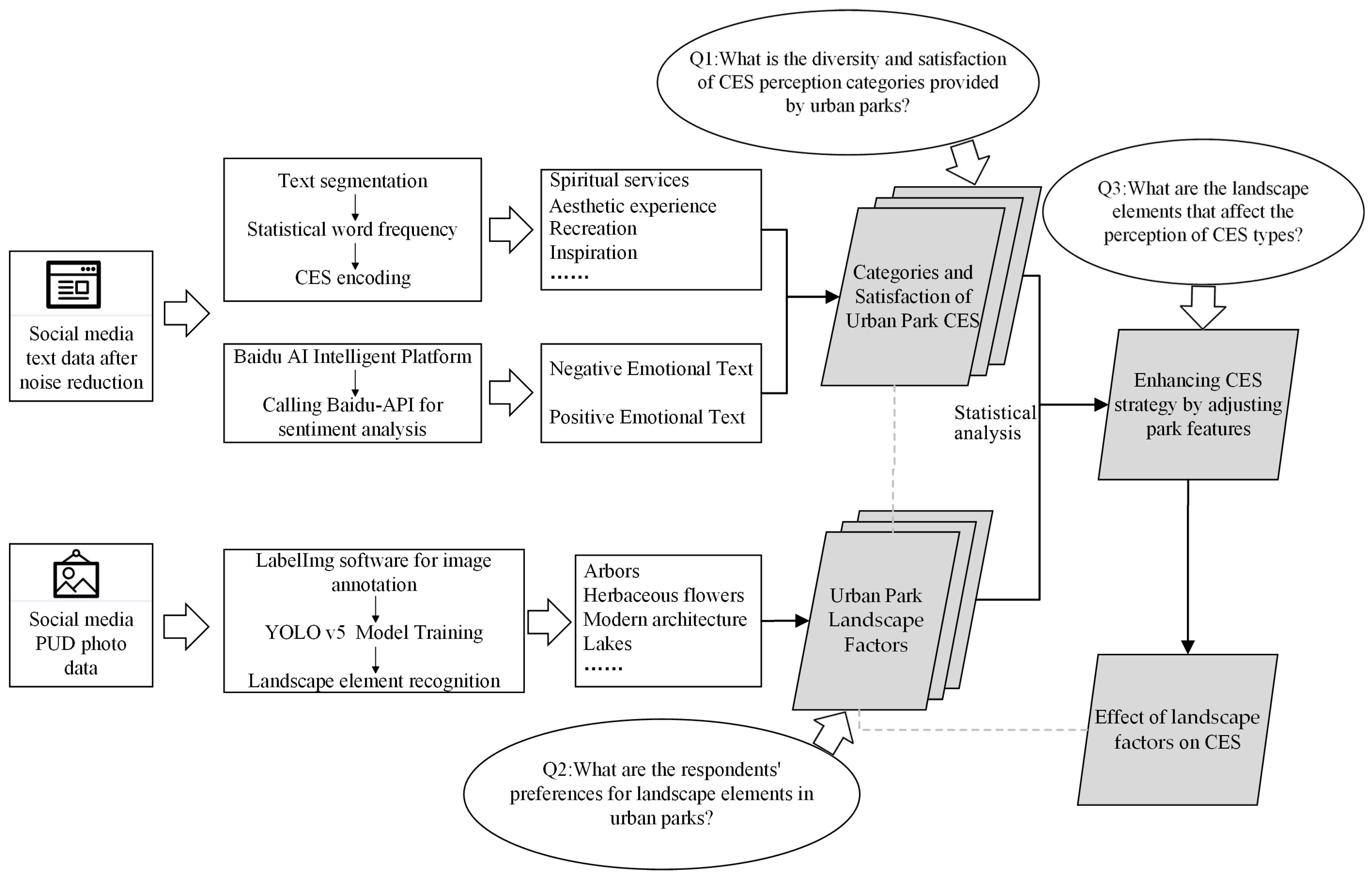
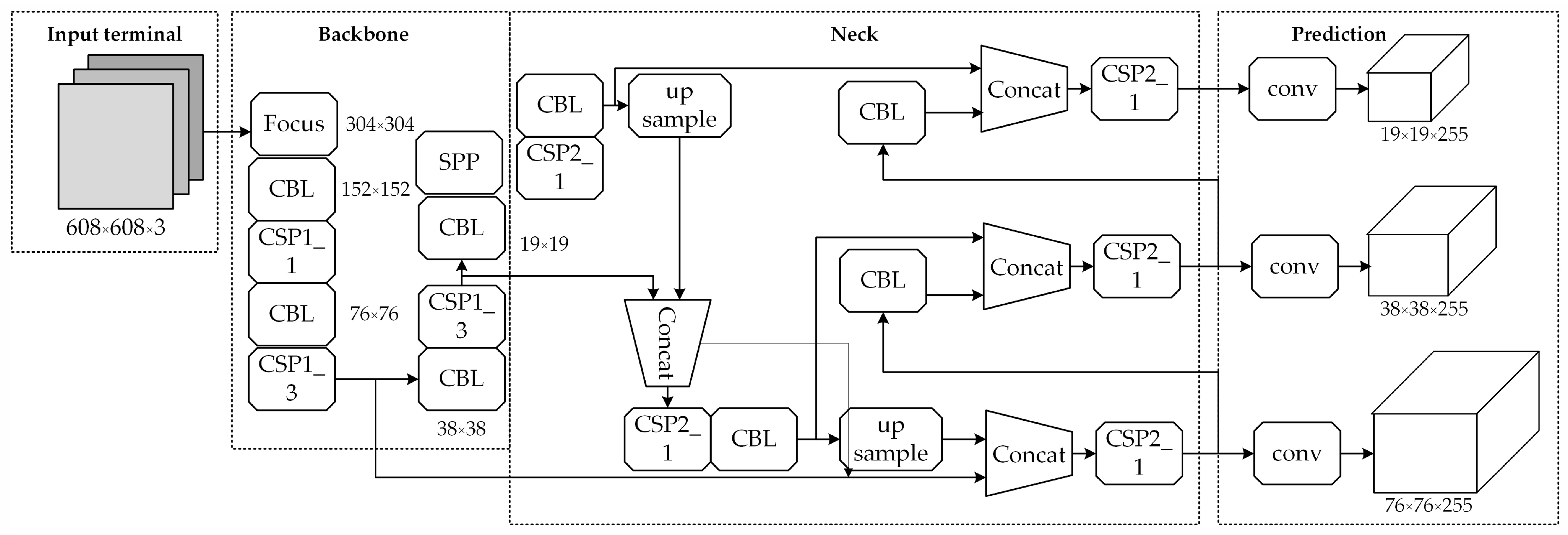

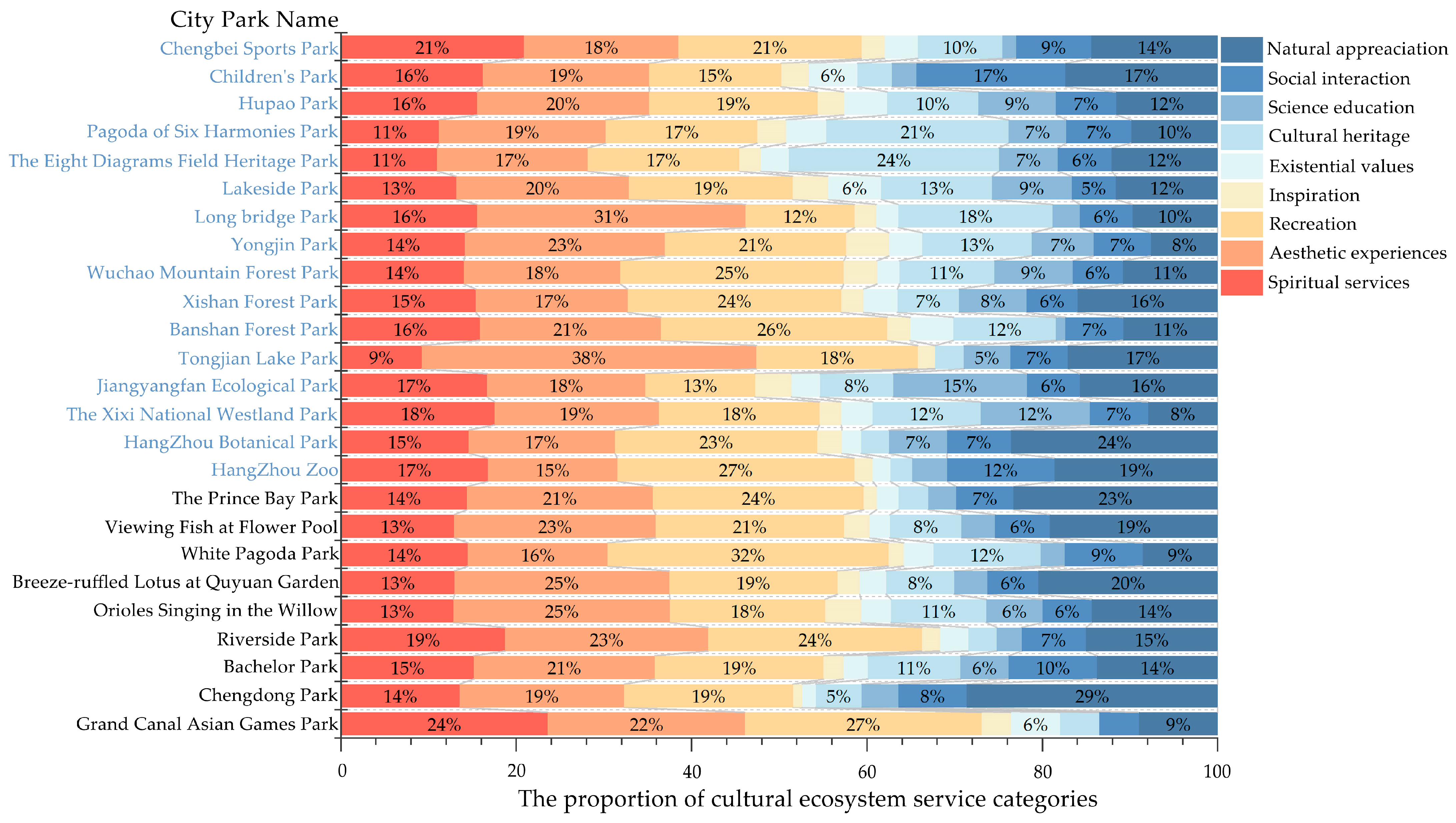

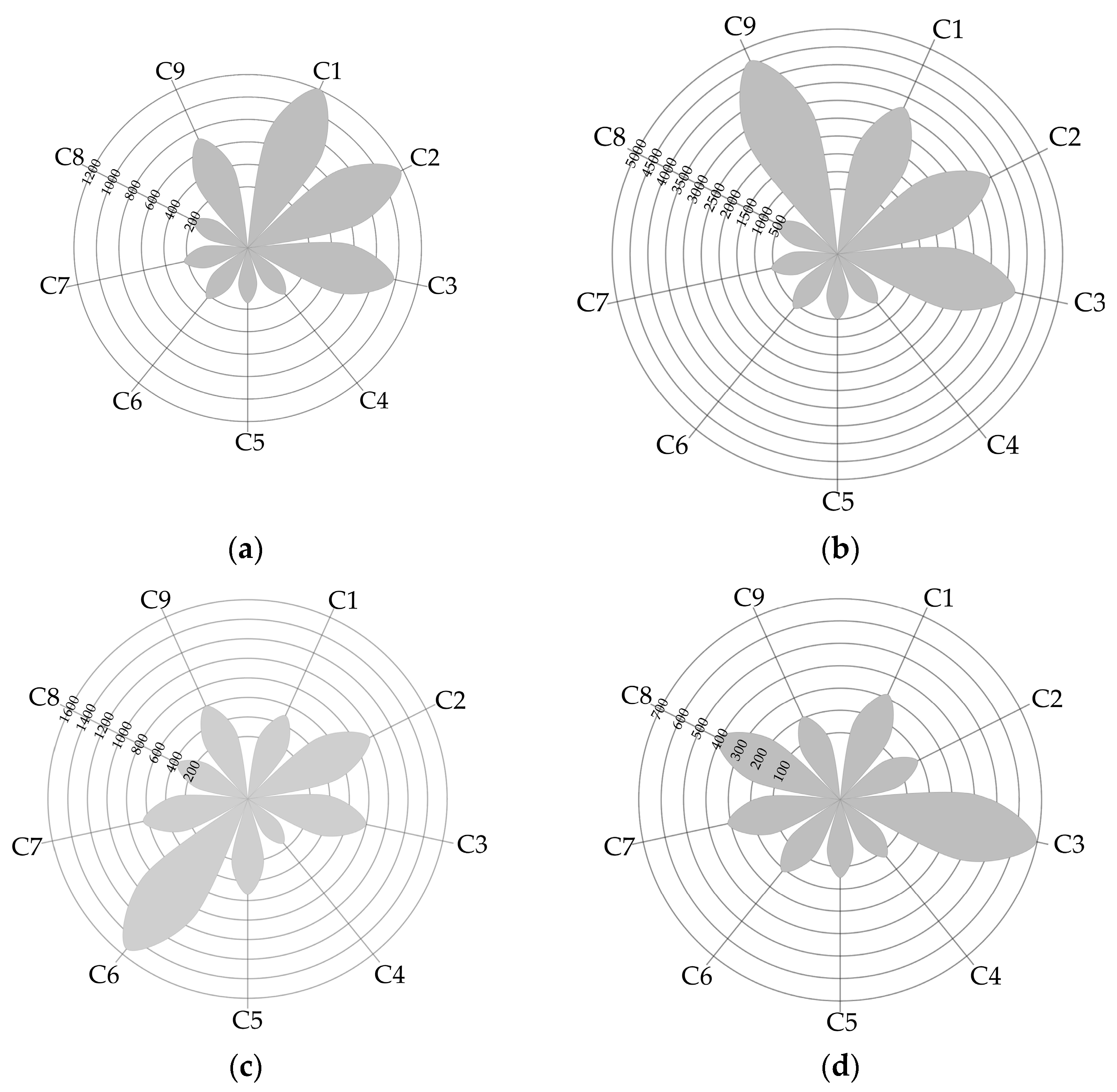

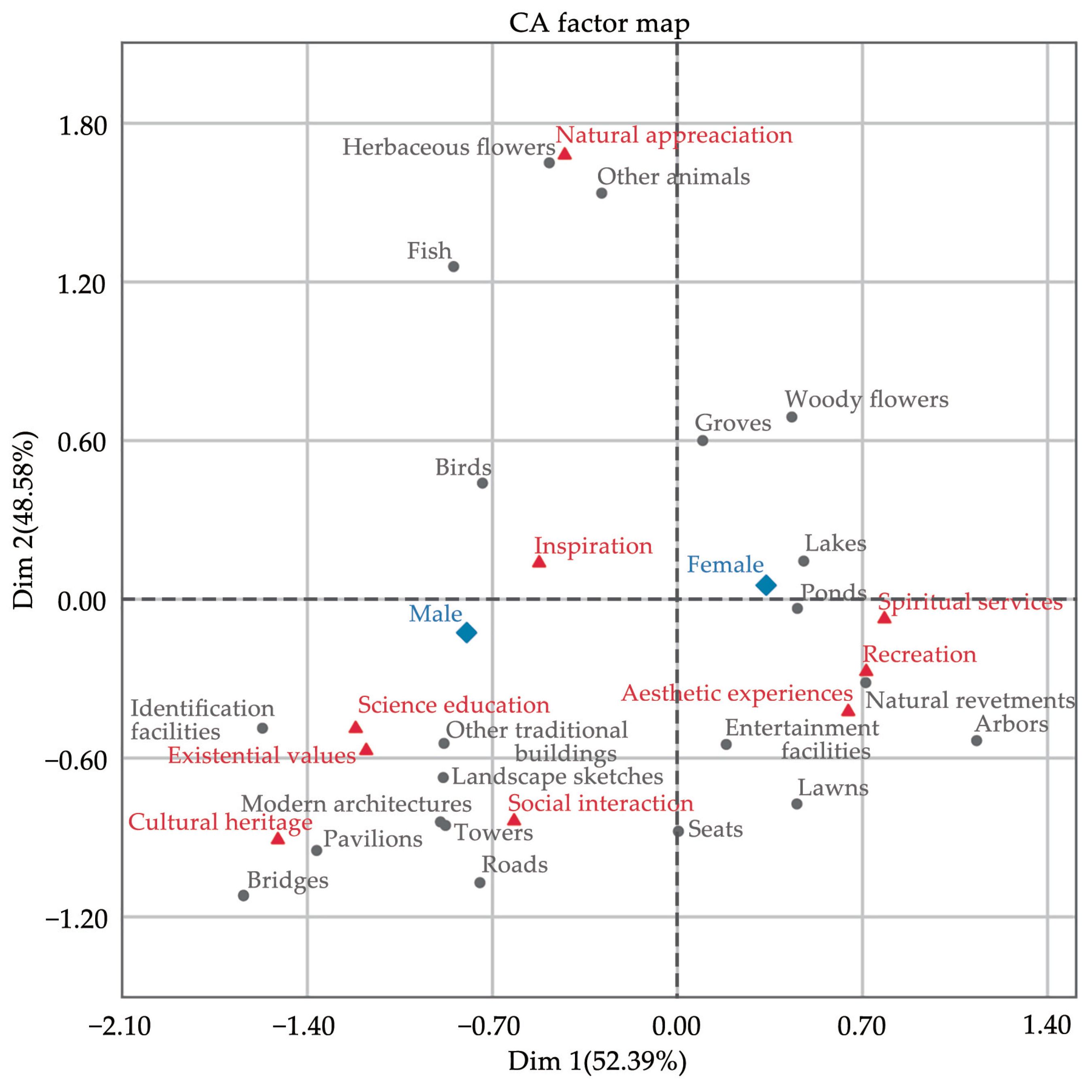
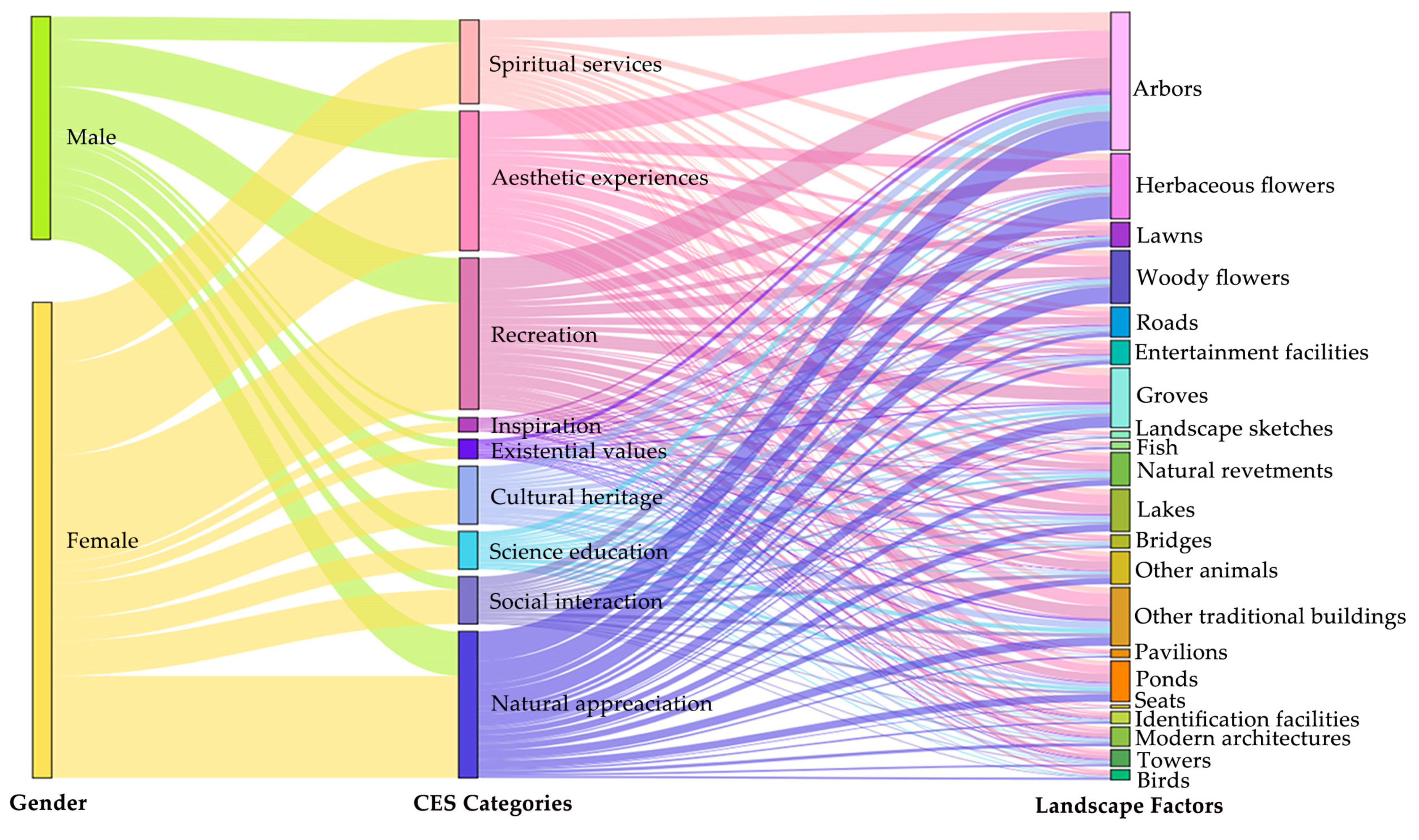
| CES Categories | Indicator Connotation | Code | Partially Matched Keywords |
|---|---|---|---|
| Spiritual services | Forgetting worries and feeling respect for nature. | C1 | Full of vitality, enrich, satisfaction, spirit, leisure, feel grateful |
| Aesthetic experiences | Experience the charming scenery, attractions, sounds or smells here. | C2 | Floral fragrance, beautiful scenery, super good-looking, spring scenery, beautiful |
| Recreation | Conduct various leisure and recreational activities in urban parks. | C3 | Recreation, picnic, take a walk, take a picture, fly a kite, climb mountain, boating |
| Inspiration | The artistic inspiration inspired by the park landscape. | C4 | Inspiration, creation, design, interests, inquisitive, thought, crafty |
| Existential values | A place that can generate a sense of connection and belonging, leading to nostalgia. | C5 | Sense of belonging, landmark building, landmark, cherish the memory of, famous, symbolize |
| Cultural heritage | The cultural and historical value contained in urban parks. | C6 | History, culture, artistic atmosphere, cultural atmosphere, cultural heritage |
| Science education | Obtaining knowledge, science popularization, and educational opportunities through urban parks. | C7 | Education, exhibition, commemoration, study, significance, knowledge, museum |
| Social interaction | Promoting social interaction between people. | C8 | Strolling baby, with family, exchange, share, gather, connection, communicate |
| Natural appreciation | Experience the pleasure of watching or interacting with animals and plants. | C9 | Plant, animal, ornamental flowers, ornamental plant leaves, insect, feed fish, watch fish |
| CES Categories | Number of Negative Texts | Number of Active Texts | Importance | Performance (Satisfaction) |
|---|---|---|---|---|
| Spiritual services | 251 | 4868 | 17.37 | 51.00 |
| Aesthetic experiences | 399 | 7474 | 50.00 | 80.67 |
| Recreation | 691 | 9458 | 54.77 | 91.25 |
| Inspiration | 51 | 922 | 5.81 | 80.85 |
| Existential values | 42 | 1120 | 6.81 | 83.42 |
| Cultural heritage | 121 | 3098 | 18.76 | 77.46 |
| Science education | 110 | 2229 | 12.91 | 93.90 |
| Social interaction | 217 | 2807 | 17.79 | 81.74 |
| Natural appreciation | 496 | 7754 | 39.72 | 70.72 |
| Total | 2378 | 3,9730 | 24.88 | 78.97 |
| Landscape Categories | Landscape Factors | Number of Labels | Accuracy | Recall | [email protected] | mAP@[0.5 = 0.95] |
|---|---|---|---|---|---|---|
| Hydrological landscape | Lakes | 112 | 0.991 | 0.953 | 0.994 | 0.826 |
| Ponds | 163 | 0.918 | 0.660 | 0.985 | 0.747 | |
| Natural revetments | 263 | 0.890 | 0.889 | 0.952 | 0.626 | |
| Biological landscape | Arbors | 438 | 0.961 | 0.947 | 0.985 | 0.790 |
| Lawns | 69 | 0.985 | 0.927 | 0.983 | 0.769 | |
| Herbaceous flowers | 321 | 0.970 | 0.984 | 0.993 | 0.813 | |
| Woody flowers | 178 | 0.966 | 1.000 | 0.933 | 0.841 | |
| Groves | 99 | 0.980 | 0.878 | 0.988 | 0.730 | |
| Fish | 114 | 0.923 | 0.982 | 0.990 | 0.773 | |
| Birds | 77 | 0.991 | 1.000 | 0.995 | 0.712 | |
| Other animals | 227 | 0.980 | 1.000 | 0.995 | 0.841 | |
| Architecture landscape | Pavilions | 26 | 0.785 | 1.000 | 0.978 | 0.808 |
| Bridges | 70 | 0.975 | 0.971 | 0.986 | 0.768 | |
| Towers | 27 | 0.836 | 0.941 | 0.955 | 0.611 | |
| Other traditional buildings | 220 | 0.949 | 0.986 | 0.993 | 0.778 | |
| Modern architecture | 81 | 0.947 | 1.000 | 0.993 | 0.842 | |
| Facility landscape | Entertainment facilities | 127 | 0.965 | 1.000 | 0.994 | 0.811 |
| Identification facilities | 47 | 0.994 | 1.000 | 0.995 | 0.876 | |
| Seats | 40 | 1.000 | 0.966 | 0.989 | 0.754 | |
| Landscape sketches | 52 | 0.949 | 1.000 | 0.995 | 0.855 | |
| Roads | 110 | 0.956 | 0.982 | 0.994 | 0.789 |
| CES Categories | Hydrological Landscape | Biological Landscape | Architecture Landscape | Facility Landscape | Total | ||||
|---|---|---|---|---|---|---|---|---|---|
| N | % | N | % | N | % | N | % | N | |
| Spiritual services | 1208 | 3.83 | 3199 | 10.13 | 499 | 1.58 | 318 | 1.01 | 5224 |
| Aesthetic experiences | 1179 | 3.73 | 3455 | 10.94 | 957 | 3.03 | 188 | 0.60 | 5779 |
| Recreation | 984 | 3.12 | 3777 | 11.96 | 799 | 2.53 | 697 | 2.21 | 6257 |
| Inspiration | 180 | 0.57 | 427 | 1.35 | 144 | 0.46 | 129 | 0.41 | 880 |
| Existential values | 146 | 0.46 | 500 | 1.58 | 540 | 1.71 | 150 | 0.48 | 1336 |
| Cultural heritage | 231 | 0.73 | 620 | 1.96 | 1535 | 4.86 | 213 | 0.67 | 2599 |
| Science education | 234 | 0.74 | 575 | 1.82 | 655 | 2.07 | 314 | 0.99 | 1778 |
| Social interaction | 194 | 0.61 | 579 | 1.83 | 368 | 1.17 | 413 | 1.31 | 1554 |
| Natural appreciation | 721 | 2.28 | 4637 | 14.69 | 604 | 1.91 | 207 | 0.66 | 6169 |
| Total | 5077 | 16.08 | 17,769 | 56.27 | 6101 | 19.32 | 2629 | 8.33 | 31,576 |
| Number | X | Y | Number of Instances | Support Percentage | Confidence Percentage | Rule Support Percentage | Lift |
|---|---|---|---|---|---|---|---|
| 1 | C2 | C3 | 7825 | 45.32 | 60.79 | 27.55 | 1.12 |
| 2 | C1 | C2 | 5914 | 34.25 | 63.22 | 21.66 | 1.40 |
| 3 | C1 | C3 | 5914 | 34.25 | 68.28 | 23.39 | 1.26 |
| 4 | C2,0 | C3 | 5232 | 30.30 | 61.70 | 18.70 | 1.14 |
| 5 | C1,0 | C2 | 4225 | 24.47 | 61.40 | 15.02 | 1.35 |
| 6 | C1,0 | C3 | 4225 | 24.47 | 68.17 | 16.68 | 1.26 |
| 7 | C9,C2 | C3 | 4055 | 23.49 | 63.87 | 15.00 | 1.18 |
| 8 | C1,C3 | C2 | 4038 | 23.39 | 66.86 | 15.64 | 1.48 |
| 9 | C9,C3 | C2 | 3874 | 22.44 | 66.86 | 15.00 | 1.48 |
| 10 | C1,C2 | C9 | 3739 | 21.66 | 60.76 | 13.16 | 1.53 |
| 11 | C1,C2 | C3 | 3739 | 21.66 | 72.21 | 15.64 | 1.34 |
Disclaimer/Publisher’s Note: The statements, opinions and data contained in all publications are solely those of the individual author(s) and contributor(s) and not of MDPI and/or the editor(s). MDPI and/or the editor(s) disclaim responsibility for any injury to people or property resulting from any ideas, methods, instructions or products referred to in the content. |
© 2024 by the authors. Licensee MDPI, Basel, Switzerland. This article is an open access article distributed under the terms and conditions of the Creative Commons Attribution (CC BY) license (https://creativecommons.org/licenses/by/4.0/).
Share and Cite
Chen, Y.; Hong, C.; Yang, Y.; Li, J.; Wang, Y.; Zheng, T.; Zhang, Y.; Shao, F. Mining Social Media Data to Capture Urban Park Visitors’ Perception of Cultural Ecosystem Services and Landscape Factors. Forests 2024, 15, 213. https://doi.org/10.3390/f15010213
Chen Y, Hong C, Yang Y, Li J, Wang Y, Zheng T, Zhang Y, Shao F. Mining Social Media Data to Capture Urban Park Visitors’ Perception of Cultural Ecosystem Services and Landscape Factors. Forests. 2024; 15(1):213. https://doi.org/10.3390/f15010213
Chicago/Turabian StyleChen, Yaxin, Chuanchun Hong, Yifan Yang, Jiaxin Li, Yu Wang, Tianyu Zheng, Yinke Zhang, and Feng Shao. 2024. "Mining Social Media Data to Capture Urban Park Visitors’ Perception of Cultural Ecosystem Services and Landscape Factors" Forests 15, no. 1: 213. https://doi.org/10.3390/f15010213





